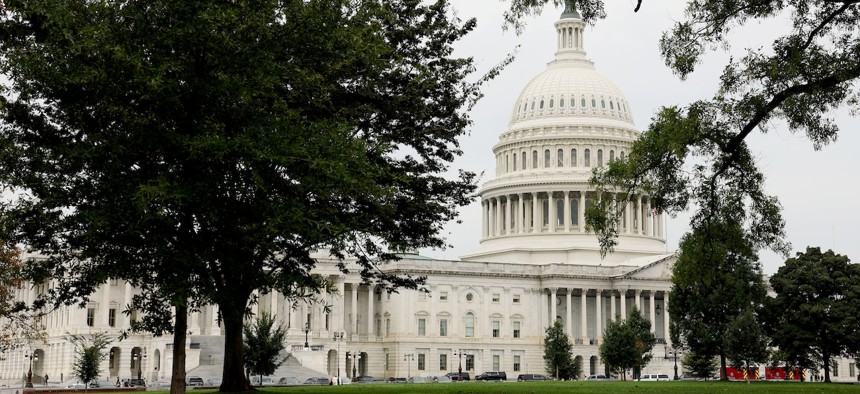
House lawmakers returned Wednesday to vote on the spending package. President Trump is expected to quickly sign it into law. Anna Moneymaker/Getty Images
Government to reopen after House votes to end longest-ever shutdown
Many furloughed workers, who will receive backpay, were already told Wednesday to report to work the following day for the first time in nearly six weeks.
Updated Nov. 13 at 8:13 a.m.
The federal government is set to reopen after being shut down for a record-setting 43 days after the House on Wednesday evening approved a bill to resume operations across agencies.
President Trump quickly signed the spending package into law, meaning agencies were set to open Thursday morning. Most agencies are now funded through January under the new stopgap continuing resolution, though the Veterans Affairs Department, Agriculture Department and legislative branch agencies are funded through September.
More than one million federal employees who worked or were furloughed during the shutdown without pay will soon begin receiving regular paychecks, as well as backpay for the checks they missed for the duration of the funding lapse. Around 650,000 furloughed workers are expected to quickly return to their offices and begin digging out from the piles of missed work during the shutdown, with most of those employees likely expected back first-thing Thursday. The funding deal guarantees those workers receive backpay despite the Trump administration threatening to flout a 2019 law that already required such retroactive compensation.
Ahead of the House vote on Wednesday, the White House said the spending package “ends disruptions to programs the American people rely on and ensures the thousands of federal employees who have been forced to work without a paycheck, such as air traffic controllers, will be promptly paid.” Trump said upon signing the measure that normal operations would resume and demonstrated he would “never give into extortion.”
As in the Senate, Democrats voted against the deal as it did not take any affirmative step to abate health care premium increases for millions of Americans next year, the key demand that led to the shutdown in the first place. The agreement came together over the weekend when eight Senate Democrats joined nearly all Republicans to approve the bill after stating the funding lapse was hurting too many people to allow it to continue.
In one concession to Democrats, the bill will unwind the more than 4,000 layoffs the Trump administration issued during the shutdown. Those reductions in force are currently paused by a federal court, though the injunction is only slated to last as long as the shutdown is in effect. The Trump administration has mostly not indicated whether it would seek to move forward with the RIFs after the government reopens.
White House Press Secretary Karoline Leavitt said on Wednesday the now-reversed layoffs marked just a small proportion of the hundreds of thousands of federal workers the Trump administration has removed from or incentivized to leave government.
“We've done a lot of great work on that front and we will continue to, but obviously the president's main priority was to reopen the federal government and get people back to work, and that's what this deal accomplishes,” Leavitt said.
The legislation will ban all agencies from carrying out any RIFs through January. The package of three full-year funding bills largely rejects funding cuts proposed by President Trump, particularly those within USDA.
The measure will also ensure the Trump administration follows a 2019 law that guarantees backpay for all federal workers furloughed during the shutdown, something the White House had suggested it would not do. Those who worked during the shutdown are also guaranteed retroactive pay.
Most employees were prepared to return to work on Thursday. Typically, the process of reopening government formally begins when the Office of Management and Budget director issues a memo ordering furloughed employees to return to work and for agencies to reopen in a “prompt and orderly manner.” OMB also maintains a checklist for agencies to resume normal activities, spelling out considerations related to communications with employees, getting employees paid as quickly as possible, prioritizing the workload and handling contracts.
Furloughed federal workers are generally told not to check their government email or use their official devices during a shutdown, though they are instructed to stay apprised of the news and to check in when funding appears imminent. Already on Wednesday ahead of the House vote, several employees told Government Executive they had received either formal communications or informal messages from their supervisors. The Interior Department, for example, told employees to prepare to report for duty on Thursday, some of whom were told they could telework if necessary. One furloughed Agriculture Department was initially told to report on Friday, but by Wednesday evening the message was updated fo instead show up on Thursday.
The Health and Human Services Department sent a note to employees that it was hopeful the shutdown would end Wednesday.
“All employees who were furloughed must report for duty at their official duty station on Thursday, Nov. 13 if the bill is signed into law tonight or tomorrow morning,” HHS said.
Late Wednesday night, OMB Director Russ Vought issued a memorandum officially telling agencies to reopen on Thursday. He thanked federal employees for their “work on behalf of the American people to usher in President Trump's Golden Age of America.”
This story has been updated with additional details.
Share your news tips with us: Eric Katz: ekatz@govexec.com, Signal: erickatz.28
NEXT STORY: Longtime Agriculture tech executive departs government







